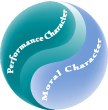 ome of the most powerful ideas are disarmingly simple. That’s certainly the case with a comprehensive, Foundation-funded report that takes the idea of character education one step further by introducing the notion of “performance character”—defined as “those qualities such as diligence, perseverance, ingenuity and self-discipline that are needed to realize one’s potential.” The Smart & Good High Schools: Developing Excellence and Ethics for Success in School, Work, and Beyond, co-authored in 2005 by Dr. Thomas Lickona, is based on visits to 24 high schools nationwide and interviews with hundreds of students, teachers and administrators. In what would seem an obvious but rarely enunciated truism, the report emphasizes the need for both moral character and performance character. ome of the most powerful ideas are disarmingly simple. That’s certainly the case with a comprehensive, Foundation-funded report that takes the idea of character education one step further by introducing the notion of “performance character”—defined as “those qualities such as diligence, perseverance, ingenuity and self-discipline that are needed to realize one’s potential.” The Smart & Good High Schools: Developing Excellence and Ethics for Success in School, Work, and Beyond, co-authored in 2005 by Dr. Thomas Lickona, is based on visits to 24 high schools nationwide and interviews with hundreds of students, teachers and administrators. In what would seem an obvious but rarely enunciated truism, the report emphasizes the need for both moral character and performance character.
“We think that if the character education movement is going to survive and grow, then it has to expand the definition of character to include both moral and performance,” says Dr. Lickona, a Developmental Psychologist and Professor of Education at the State University of New York at Cortland. He authored the report with Matt Davidson, a colleague at the Center for the Fourth and Fifth Rs (Respect and Responsibility), which Lickona directs.
Major support for the Smart & Good High Schools report came from the Templeton Foundation’s College and Character Initiative, which seeks to reinforce the positive values instilled by parents—honesty, compassion, self-discipline and respect for example. The Foundation’s ultimate aim echoes one voiced by the Rev. Dr. Martin Luther King, Jr.: “Intelligence plus character—that is the goal of a true education.”
The report’s findings—a concise collection of best practices for creating an ethical learning community—are gradually resonating across the country. A mailing to 26,000 school principals was followed by the report’s distribution to 10,000 journalists, administrators and opinion makers in the world of education. Several school districts ordered copies of Smart & Good High Schools for their entire teaching staffs for group study. The New Hampshire’s education department is considering using the report as a blueprint statewide. Tom Stoup, a high school principal at the private Carrollwood Day School in North Tampa, Florida, calls the report invaluable.
“I feel like we are going to be using absolutely every aspect of it,” says Stoup, who predicts the new approach to character education will yield impressive results nationally. “This is a whole new paradigm for high schools. It’s not just about getting into college and getting credits… You are also going to be evaluated on your commitment to the community, to the state and
to the world.”
Aside from laying out a hands-on approach to creating a school environment grounded in character, Lickona and Davidson also offer a detailed list of those attributes that give students character. These are qualities that range from being skilled socially to thinking critically and being spiritual. This last attribute is the subject of considerable discussion in the report because, as Lickona explains, “That’s language that hasn’t been used in the public domain. It could make some people nervous.”
The next step for the authors of Smart & Good High Schools is to implement the report through a series of pilot programs in high schools around the country.
www.templeton.org/funding_areas/show_profiles.asp?p=10438&b=1|30 and
www.cortland.edu/character/highschools
 |
Performance character is a mastery orientation.
It consists of those qualities—such as diligence, a strong work ethic, a positive attitude, perseverance, ingenuity, and self-discipline—needed to realize one’s potential for excellence in school, the workplace, or any area of endeavor.
Moral character is a relational orientation.
It consists of those qualities—such as integrity, justice, caring, respect, responsibility, and cooperation—needed for successful interpersonal relationships and ethical behavior. |
|
|